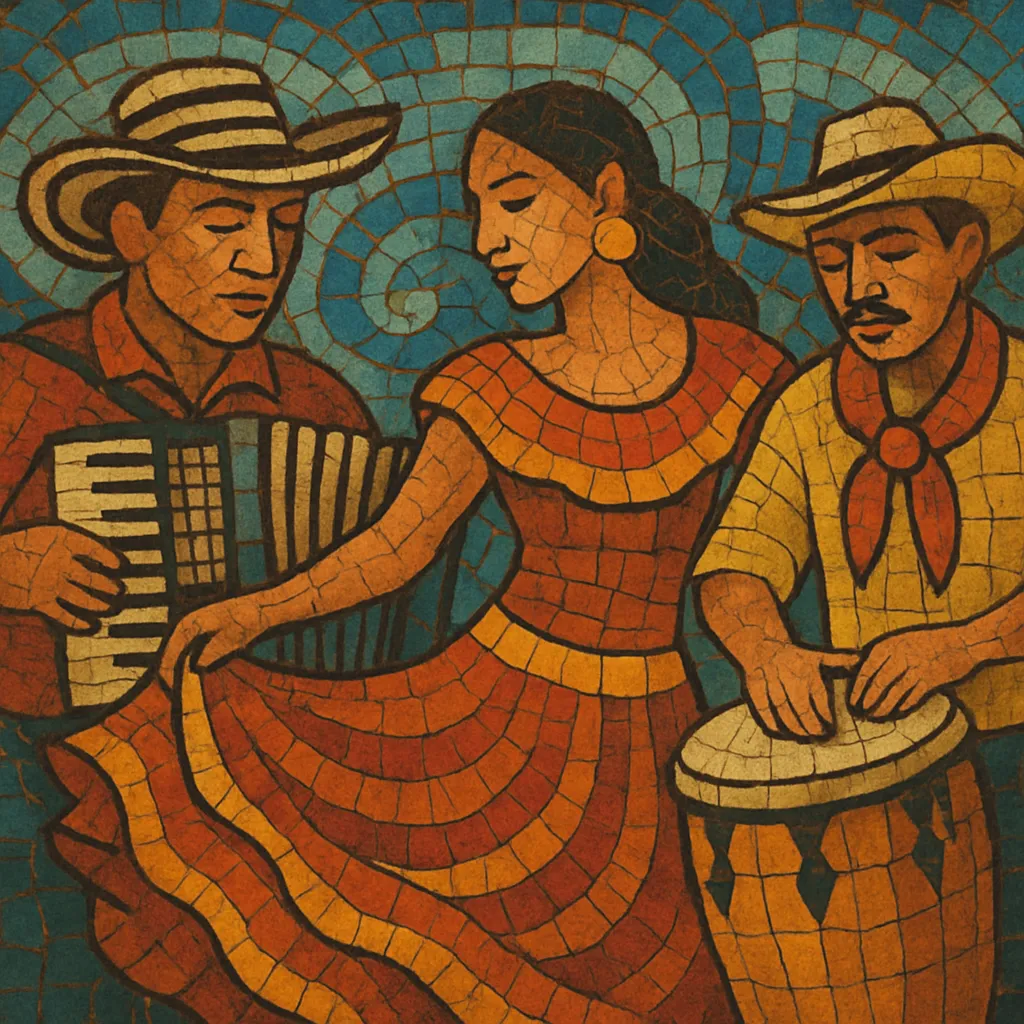Cumbia is a syncretic dance-music tradition from Colombia’s Caribbean coast that blends African rhythmic heritage, Indigenous (especially gaita flute) melodic practice, and Spanish colonial instrumentation and forms.
Traditionally performed in a moderate 2/4 (often felt in 4/4 today), it features interlocking hand-drum parts (tambora, alegre, llamador), guacharaca or maracas for steady texture, and long cane flutes (gaita hembra and gaita macho) carrying call-and-response melodies. As it spread in the 20th century, orchestras and dance bands added accordion, horns, piano, bass, and later electric guitar and synthesizers, creating urban and pan–Latin American variants.
Harmonically simple and rhythm-forward, cumbia places groove, ostinati, and vocal refrains at the center, making it both ceremonial in origin and enduringly popular on social dance floors across the Americas.
Cumbia emerged along Colombia’s Caribbean coast through a fusion of African diasporic drumming and dance, Indigenous aerophone (gaita) traditions, and Spanish colonial song and procession practices. By the 1800s, it had recognizable characteristics as a courtship dance and an open-air procession music featuring hand drums, shakers, and flutes.
In the early 1900s, coastal towns and river ports circulated cumbia alongside related coastal genres like bullerengue and porro. Local ensembles standardized drum roles (tambora, alegre, llamador), maracas/guacharaca patterns, and gaita duets (hembra for melody, macho for countermelodies and responses).
From the 1940s–1960s, radio and recording catalyzed national and international exposure. Band leaders and arrangers adapted cumbia to big-band/orquesta settings—adding horns, piano, and bass—while interacting with contemporaneous Caribbean currents like son cubano and mambo. Foundational recordings by Colombian orchestras made cumbia a staple of urban dance halls from Barranquilla to Bogotá and beyond.
By the 1960s–1980s, cumbia had radiated through Mexico, Peru, Chile, Argentina, and Central America, where it hybridized with local instruments and tastes: Mexican sonidera and norteña inflections, Peru’s psychedelic/Amazónica guitar sound, and Argentina’s santafesina and later villera scenes. Each region localized tempo, instrumentation, and lyrical themes while keeping cumbia’s core rhythm and call-and-response hooks.
The 1990s–present saw DJ culture and digital production birth styles like cumbia rebajada and digital cumbia, and a wave of "nueva cumbia" artists mixing rock, hip hop, and electronic textures. International touring, crate-digging reissues, and internet scenes cemented cumbia as a hemispheric—and increasingly global—dance continuum, balancing tradition with constant reinvention.
Aim for a moderate dance tempo around 90–110 BPM. Traditional cumbia feels like a lilting 2/4 (often realized in 4/4 in modern bands).
•Build the groove from interlocking percussion:
•Tambora: anchors the cycle with bassy downbeats and occasional fills.
•Alegre: provides syncopated mid-voice patterns and responsive accents.
•Llamador: steady, clipped strokes that lock the pulse.
•Guacharaca or maracas: continuous rasp/shake for texture and forward drive.


